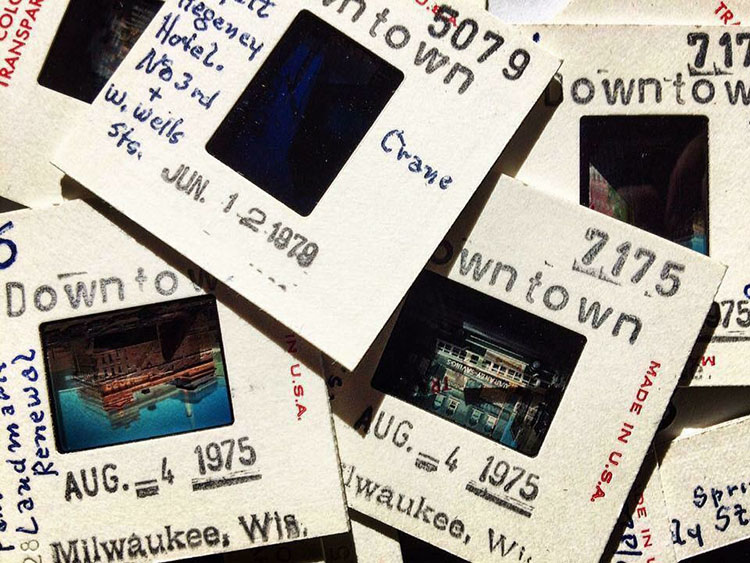Milwaukee is always changing. For every new building erected, every new amenity added, or for each conceptual change and ownership overhaul that happens in our city, a piece of Milwaukee’s past is lost in the process. Change isn’t always a bad thing, but an unfortunate byproduct of it is that each addition to Milwaukee’s long and growing story makes it a little harder to look back and appreciate the earlier chapters. Thanks to Adam Levin, the difficult task of documenting and remembering the city’s history has become a little easier.
Levin operates the “Old Milwaukee” Facebook group, an online community that functions as “an appreciation for the people, lives, and architecture from Milwaukee’s past.” The 45-year-old Milwaukee native, who moved back to the region last August after stops in Minneapolis and New Jersey, was offered the page—which Levin recalls was named something along the lines of “You Know You’re From Milwaukee If…” at the time—about two and a half years ago.
He immediately changed the name to Old Milwaukee and swapped in the neon sign cover photo. “It’s two of my favorite things: vintage signs and the history of Milwaukee,” Levin says. When he took the reins in October of 2015, the page had approximately 1,000 members. Presently, Levin is joined in the group by 31,600 others.
 Levin thinks the visual focus, instead of fact-laden posts, is one of the reasons the page’s popularity has increased so quickly.
Levin thinks the visual focus, instead of fact-laden posts, is one of the reasons the page’s popularity has increased so quickly.
“I’m not trying to give a history lesson because I don’t know it all,” Levin says. “I think I have an eye for the obscure photos and I think that’s what’s made it so popular. I’m not posting the same Treasure Island photo that’s been posted 100,000 times. I just try to find things that are a little obscure. You just have to dig a little.”
The amateur photographer shoots many of the images that appear on the page and he’s also an avid collector of vintage photographs, including a batch of 1970s era Kodachrome slides from photographer Ray Szopieray that he found at an antique store.

“I go to estate sales, not to look for furniture; I look for photos. That’s where you can find some really cool photos that people will normally just throw away,” Levin says. “You never know what you can find.”
Of course, Levin also encourages the group’s members to to contribute their own photos and memories to the page. He also recognizes the power old imagery and experiences have to bring people together in the virtual community.

“There’s a lot of connection that people make from the page. I’ve had people tell me that Old Milwaukee has helped them reconnect with old friends,” Levin says. “It’s crazy how many people come out of the woodwork, and not just people from here. There are a lot of people in different states in the group, people who live in different states but miss it and want to stay connected.”
Though Levin welcomes contributions from current Milwaukeeans and past residents alike, he asks that those posting on the page he maintains as a hobby adhere to criteria: the posts apply to Milwaukee, they’re from the past, and that political commentary is avoided. However, he’s quickly learned certain topics inevitably lead to controversy and arguments.
“I know there are these topics that people will go coo-coo over: Northridge Mall, Jeffrey Dahmer, Father Groppi, and the street car,” Levin says. “You can put up photos from the 1950s and it will come back to 2018. I don’t care what side you’re on, that’s not the point of the photo. It’s not ‘New Milwaukee,’ it’s ‘Old Milwaukee.’ But I understand these photos elicit emotion from these people where either they hate it or they love it.”

While he doesn’t draw a paycheck from the page that’s become much more time-consuming than he’d initially expected, Levin does his best to use his administrative role to keep negativity off the page.
“I try to keep it out of the group because sometimes people just want to take a break from reality,” Levin says. “I’m not living in the past, I’m appreciating it. There are other avenues and platforms to get political.”
Recently, that online appreciation turned into real life change when Levin was able to use the group to successful crowdfund the money needed to purchase and transport a 26-foot vintage Goldman’s sign that’s currently in North Dakota back to Milwaukee. The sign will be transported to Waukesha, where it will be refurbished, before being reinstalled near its former home on Mitchell Street.

“It will go about two or three blocks east of where it used to be, so it will be a nice little remembrance of Goldman’s. If it’s a passion, then it isn’t effort,”
Though Levin would love to use the page as a resource to make Milwaukee a little older by saving vintage neons and pushing for the preservation of “ghost signs,” the historical hobbyist is more than happy to help to give people the ability to look back on Milwaukee’s rich and inimitable past as the city’s story rolls grows longer with each passing day and every new development.
“I really just want to keep on doing what I’m doing with it, and if people enjoy it still, that’s great. I wouldn’t keep on doing it if people didn’t enjoy it,” Levin says. “It would be great if it could bring some positive changes to Milwaukee. If Captain’s Restaurant re-opened because of this, that would be great. If it literally opened the door of a place I could get into, that would be great. But it’s just a hobby.”


